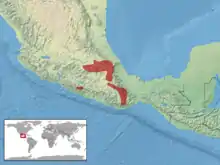| Crotalus ravus | |
|---|---|
 | |
| Scientific classification | |
| Domain: | Eukaryota |
| Kingdom: | Animalia |
| Phylum: | Chordata |
| Class: | Reptilia |
| Order: | Squamata |
| Suborder: | Serpentes |
| Family: | Viperidae |
| Genus: | Crotalus |
| Species: | C. ravus |
| Binomial name | |
| Crotalus ravus (Cope, 1865) | |
 | |
| Synonyms[2] | |
| |
Crotalus ravus, commonly known as the Mexican pigmy rattlesnake[3] or Mexican pygmy rattlesnake,[4] is a venomous pit viper species, found only in Mexico. Three subspecies are currently recognized.[5]
Taxonomy
A study using mitochondrial DNA strongly suggests that C. ravus is part of a species complex including Crotalus triseriatus, Crotalus pusillus, Crotalus aquilus, and Crotalus lepidus.[6] This study also confirmed strong genetic differentiation among the three subspecies aligning with geographic barriers. A follow-up study using seven nuclear markers places S. ravus basal to all other members of the species complex.[7]
Subspecies
| Subspecies[5] | Taxon author[5] | Common name[8] | Geographic range[4] |
|---|---|---|---|
| C. r. brunneus | Harris & Simmons, 1977 | Oaxacan pygmy rattlesnake | Mexico in the highlands of Oaxaca. |
| C. r. exiguus | Campbell & Armstrong, 1979 | Guerreran pygmy rattlesnake | Mexico in the Sierra Madre del Sur of central Guerrero. |
| C. r. ravus | (Cope, 1865) | Central Mexican pygmy rattlesnake | Mexico in the Altiplanicie Meridional, including the states of México, Morelos, Tlaxcala, Puebla, and Veracruz. |
Description
Adults of this species usually grow to a length of 40–65 centimetres (16–26 in), but may reach more than 70 cm (28 in). They are moderately stout in build.[4]
The distinguishing characteristics for the nominate subspecies C. r. ravus include parietal scales that are highly variable in shape and particularly large, less than 3 prefoveals, 21 midbody dorsal scales, 2–4 tail bands and a relatively large rattle.[4]
Distribution
Found only in Mexico in the mountains in the center and south of the country, west of the Isthmus of Tehuantepec. Its range includes the southeastern part of the Mexican Plateau in the highlands of Mexico, Morelos, Tlaxcala, Puebla, Veracruz, Oaxaca, and the Sierra Madre del Sur in Guerrero. The type locality given is the "Table land of Mexico." Cochran (1961) interpreted this to be the "south tableland, Veracruz, Mexico."[2]
Campbell and Lamar (2004)[4] describe this species as being found across the Mexican Plateau in the temperate regions of moderate to high elevations. They estimate the vertical distribution to be from about 1,490 metres (4,890 ft) above sea level to a little over 3,000 m (9,800 ft) altitude.[4]
Conservation
Although being listed as of "Least Concern" by the IUCN, C. ravus was listed as "threatened" by the Mexican government in 2010.[9]
References
- ↑ Canseco-Márquez, L.; Mendoza-Quijano, F. (2007). "Crotalus ravus". IUCN Red List of Threatened Species. 2007: e.T64330A12771045. doi:10.2305/IUCN.UK.2007.RLTS.T64330A12771045.en. Retrieved 19 November 2021.
- 1 2 McDiarmid RW, Campbell JA, Touré T. 1999. Snake Species of the World: A Taxonomic and Geographic Reference, vol. 1. Herpetologists' League. 511 pp. ISBN 1-893777-00-6 (series). ISBN 1-893777-01-4 (volume).
- ↑ Klauber LM. 1997. Rattlesnakes: Their Habitats, Life Histories, and Influence on Mankind. Second Edition. 2 volumes. Reprint, University of California Press, Berkeley. ISBN 0-520-21056-5.
- 1 2 3 4 5 6 Campbell JA, Lamar WW. 2004. The Venomous Reptiles of the Western Hemisphere. Comstock Publishing Associates, Ithaca and London. 870 pp. 1500 plates. ISBN 0-8014-4141-2.
- 1 2 3 "Crotalus ravus". Integrated Taxonomic Information System. Retrieved 4 March 2007.
- ↑ Bryson, Robert W. (2011). "Evolutionary drivers of phylogeographical diversity in the highlands of Mexico: a case study of the Crotalus triseriatus species group of montane rattlesnakes". Journal of Biogeography. 38 (4): 697–710. doi:10.1111/j.1365-2699.2010.02431.x. S2CID 83843594.
- ↑ Bryson, Robert W. Jr.; Linkem, Charles W.; Dorcas, Michael E.; Lathrop, Amy; Jones, Jason M.; Alvarado-Diaz, Javier; Grusnwald, Christoph I.; Murphy, Robert W. (2014). "Multilocus species delimitation in the Crotalus triseriatus species group (Serpentes: Viperidae: Crotalinae), with the description of two new species". Zootaxa. 3826 (3): 475–496. doi:10.11646/zootaxa.3826.3.3. PMID 24990060.
- ↑ Sistrurus ravus at the Reptarium.cz Reptile Database. Accessed 12 December 2007.
- ↑ NOM-059-SEMARNAT-2010, http://dof.gob.mx/nota_detalle.php?codigo=5173091&fecha=30/12/2010
